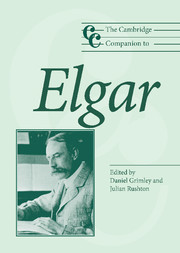Book contents
- Frontmatter
- 1 Introduction
- 2 Elgar and his British contemporaries
- 3 Elgar and his publishers
- 4 Magic by mosaic: some aspects of Elgar's compositional methods
- 5 Elgar's musical language: the shorter instrumental works
- 6 The early choral works
- 7 Elgar's later oratorios: Roman Catholicism, decadence and the Wagnerian dialectic of shame and grace
- 8 Roman Catholicism and being musically English: Elgar's church and organ music
- 9 ‘A smiling with a sigh’: the chamber music and works for strings
- 10 In search of the symphony: orchestral music to 1908
- 11 The later orchestral music (1910–34)
- 12 Elgar's unwumbling: the theatre music
- 13 Elgar and recording
- 14 Broadcasting's ally: Elgar and the BBC
- 15 Elgar in German criticism
- 16 Functional music: imperialism, the Great War, and Elgar as popular composer
- Notes
- Select bibliography
- Index
11 - The later orchestral music (1910–34)
Published online by Cambridge University Press: 28 September 2011
- Frontmatter
- 1 Introduction
- 2 Elgar and his British contemporaries
- 3 Elgar and his publishers
- 4 Magic by mosaic: some aspects of Elgar's compositional methods
- 5 Elgar's musical language: the shorter instrumental works
- 6 The early choral works
- 7 Elgar's later oratorios: Roman Catholicism, decadence and the Wagnerian dialectic of shame and grace
- 8 Roman Catholicism and being musically English: Elgar's church and organ music
- 9 ‘A smiling with a sigh’: the chamber music and works for strings
- 10 In search of the symphony: orchestral music to 1908
- 11 The later orchestral music (1910–34)
- 12 Elgar's unwumbling: the theatre music
- 13 Elgar and recording
- 14 Broadcasting's ally: Elgar and the BBC
- 15 Elgar in German criticism
- 16 Functional music: imperialism, the Great War, and Elgar as popular composer
- Notes
- Select bibliography
- Index
Summary
Whatever Elgar actually said concerning ‘absolute music’ in his Birmingham lecture on Brahms's Symphony No. 3, and whatever he actually meant to say, to view his own symphonies and concertos as ‘purely tonal pattern-weaving’, to use Ernest Newman's phrase, would be to deny an essential – perhaps the essential – aspect of one's experience of them. A more productive approach is to see these works as ‘fixing’ by means of a highly sophisticated compositional technique a series of emotional states or attitudes, these being bound up to a large extent with aspects of the composer's own life. Various comments by Elgar confirm – or, at the very least, suggest – that this is the case. Indeed, both the Violin Concerto and Symphony No. 2 have prefatory inscriptions that point to extra-musical impulses, their enigmatic nature increasing the listener's desire to search for ‘meaning’. Meanwhile it could be said that Falstaff, described by the composer as a ‘symphonic study’, differs chiefly to the extent that the subject-matter is precisely identified and specific events illustrated. What follows is an interpretation of Elgar's later orchestral music (the works already mentioned, plus the Cello Concerto and Anthony Payne's elaboration of the sketches for Symphony No. 3) that pivots around what this particular author perceives to be its emotional meaning, but argued from observations about technique intended to provide snapshots of Elgar's symphonic approach.
- Type
- Chapter
- Information
- The Cambridge Companion to Elgar , pp. 154 - 170Publisher: Cambridge University PressPrint publication year: 2005



